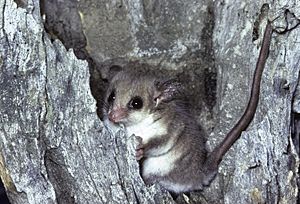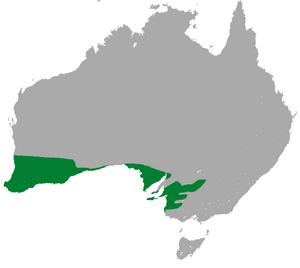Western pygmy possum facts for kids
Quick facts for kids Western pygmy possumTemporal range: Late Pleistocene – Recent
|
|
|---|---|
 |
|
| Western pygmy possum | |
| Conservation status | |
| Scientific classification | |
 |
|
| Western pygmy possum range |
The western pygmy possum (Cercartetus concinnus) is a tiny marsupial that lives in Australia. People also call it the southwestern pygmy possum or the mundarda. Scientists believe its closest family member is the eastern pygmy possum. Their ancestors split apart about eight million years ago.
Contents
Discovering the Western Pygmy Possum
The first person to describe the western pygmy possum was John Gould. He was a famous English ornithologist, meaning he studied birds. He shared his findings about this tiny possum in 1845. He gave it the scientific name Cercartetus concinnus.
Gould first thought this new species belonged to the group Dromicia. This was because it seemed similar to another species found in Tasmania. Another scientist, G. R. Waterhouse, also described the animal in the same year. However, his description was later found to be the same species.
What Does a Western Pygmy Possum Look Like?
The western pygmy possum is special among its relatives. Most other pygmy possums are grey. But this one has bright cinnamon-colored fur over most of its body. Its belly is pure white, which also helps tell it apart. It has a thin ring of dark brown fur right in front of its eyes.
This possum has long, round, flesh-colored ears. Its eyes are large, black, and stick out a bit. The area around its nose has very little hair, showing pink skin. It also has long whiskers.
Tail and Feet
The western pygmy possum has a long, grasping tail. This means it can use its tail to hold onto things. The tail is covered with tiny scales, not fur. It is not thick at the base.
Its back feet have a special first toe that can grab things. All four feet have wide pads on the tips of their toes. These pads help them grip branches.
Size and Weight
Even though it's small compared to most other possums, it's one of the larger pygmy possums. Adult possums are about 70–100 millimeters (2.8–3.9 inches) long from head to body. Their tail adds another 70–90 millimeters (2.8–3.5 inches). An adult possum weighs between 8 and 18 grams (0.3–0.6 ounces).
Female possums have a well-developed pouch. It opens to the front and has six teats. The possum's tongue is quite long for its size, up to 12 millimeters (0.5 inches).
Where Do Western Pygmy Possums Live?
These possums are at risk because their homes are disappearing. They also struggle to find enough food. They live in Southwest Australia, along the south coast, and in the wheatbelt area. You can also find them in parts of South Australia, Kangaroo Island, and Victoria. They are listed as endangered in far southwestern New South Wales.
Their Home Environment
Western pygmy possums live in semi-dry woodlands, shrublands, and heathlands. These areas are often filled with plants like Callistemon (bottlebrushes), melaleuca, banksia, and grevillea.
Scientists once thought there were two different groups of these possums. They believed the groups were separated by the Nullarbor Plain. However, genetic studies show no big differences between the eastern and western groups. Fossils of these possums have been found in the Nullarbor Plain, even though they don't live there anymore.
How Western Pygmy Possums Live and What They Eat
The western pygmy possum is a solitary animal. This means it likes to be alone. It is also nocturnal, which means it is active at night. During the day, they hide in tree hollows, cracks in rocks, bird nests, or thick bushes.
At night, they go out to find food or a mate. They usually travel about 50 meters (164 feet) each day. They might move to different areas throughout the year. This depends on where they can find the best plants for food.
Life in the Trees
These possums spend most of their time in trees. They use their strong paws and grasping tails to hold onto branches. They also use them to gather materials for their nests. They can even open flowers to get to the sweet nectar. Sometimes, they make a quick chattering noise.
Their Diet
Their main food is nectar and pollen. They especially like nectar from melaleuca and eucalyptus plants. They might even help these plants by spreading pollen, which is called pollination. They also eat insects to add to their diet.
Wild animals that hunt them include quolls, snakes, and owls. But today, they also face danger from animals brought in by humans. These include red foxes and domestic cats.
Sleeping Through Tough Times
Western pygmy possums can go into a deep sleep called torpor. They do this when the weather is bad or cold. Torpor helps them save energy and food. During torpor, which can last up to seven days, their body temperature drops. It gets very close to the temperature of the air around them. They also use only about 1% of the oxygen they normally would.
When they are in torpor, they sleep on their stomachs. Their ears are folded over their eyes. Their long tails are coiled under their bodies. They wake up from torpor much faster than other mammals their size.
Western Pygmy Possum Life Cycle
Western pygmy possums can have babies all year round. But they usually have more young in the spring. A mother possum typically gives birth to four to six babies at a time.
Sometimes, a mother might have more than six embryos inside her. However, she only has six teats. Marsupial babies stay attached to a teat for a long time when they are young. So, six is the most babies she can raise at once.
What's unusual is that a mother can give birth just two days after her last litter stops feeding. Her teats change size quickly to fit the new, smaller babies. Her milk glands also start making a special first milk called colostrum again.
Growing Up
The young possums are still blind when they leave the pouch. This happens when they are about 25 days old. They stay in the nest for a while after that. They are fully weaned, meaning they stop drinking milk, at around 50 days old. Female possums are ready to have their own babies when they are 12 to 15 months old.
Protecting the Western Pygmy Possum
The IUCN currently lists the western pygmy possum as a Least Concern animal. This means it is not in immediate danger globally.
However, in some parts of Australia, it is more at risk. Several states, like New South Wales and South Australia, list it as Vulnerable, Endangered, or Critically Endangered. This is because of several threats:
- Clearing land: Their habitat is being destroyed for human use.
- Less food: Too many farm animals eating plants (called overgrazing) reduce their food sources.
- Fires: Changes in how fires happen can harm their homes.
- New predators: Animals like the red fox and feral cats hunt them.
See also
 In Spanish: Zarigüeya pigmea del suroeste para niños
In Spanish: Zarigüeya pigmea del suroeste para niños


